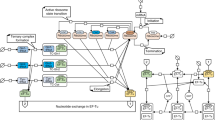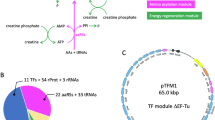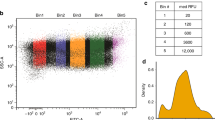Abstract
Here we show that most macromolecular biosynthesis reactions in growing bacteria are sub-saturated with substrate. The experiments should in part test predictions from a previously proposed model (Jensen & Pedersen 1990) which proposed a central role for the rates of the RNA and peptide chain elongation reactions in determining the concentration of initiation competent RNA polymerases and ribosomes and thereby the initiation frequencies for these reactions. We have shown that synthesis of ribosomal RNA and the concentration of ppGpp did not exhibit the normal inverse correlation under balanced growth conditions in batch cultures when the RNA chain elongation rate was limited by substrate supply. The RNA chain elongation rate for the polymerase transcribinglacZ mRNA was directly measured and found to be reduced by two-fold under conditions of high ppGpp levels.
In the case of translation, we have shown that the peptide elongation rate varied at different types of codons and even among codons read by the same tRNA species. The faster translated codons probably have the highest cognate tRNA concentration and the highest affinity to the tRNA. Thus, the ribosome may operate close to saturation at some codons and be unsaturated at synonymous codons. Therefore, not only translation of the codons for the seven amino acids, whose biosynthesis is regulated by attenuation, but also a substantial fraction of the other translation reactions may be unsaturated.
Recently, we have obtained results which indicate that also many ribosome binding sites are unsaturated with their substrate, i.e. with ribosomes. This observation affects the interpretation of many results obtained by use of reporter genes, because the expression from such genes is strongly influenced by the general physiology of the cell.
Similar content being viewed by others
References
Baracchini E & Bremer H (1988) Stringent and growth control of rRNA synthesis inEscherichia coli are both mediated by ppGpp. J. Biol. Chem. 263: 2597–2602
Bergmann JE & Lodish H (1979) A kinetic model of protein synthesis. Proc. Natl. Acad. Sci. USA 254: 11927–11937
Bonekamp F, Dalbøge H, Christensen T & Jensen KF (1989) Translation rates of individual codons are not correlated with tRNA abundance or with frequencies of utilization inEscherichia coli. J. Bacteriol. 171: 5812–5816
Bremer H & Dennis PP (1987) Modulation of chemical composition and other parameters of the cell by growth-rate. In: Neidhardt FC, Ingraham JC, Low KB, Magasanik B, Schaecter M & Umbarger HE (Eds)Escherichia coli andSalmonella typhimurium. Cellular and Molecular Biology (pp 1527–1542). American Society for Microbiology, Washington DC
Bulmer M (1988) Codon usage and intragenic position. J. Theor. Biol. 133: 67–71
Cashel M & Gallant J (1969) Two compounds implicated in the function of the RC gene ofEscherichia coli. Nature (London) 221: 838–841
Cashel M & Rudd KE (1987) The stringent response. In: Neidhardt FC, Ingraham JC, Low KB, Magasanik B, Schaecter M & Umbarger HE (Eds)Escherichia coli andSalmonella typhimurium. Cellular and Molecular Biology (pp 1410–1438). American Society for Microbiology, Washington DC
Clark B & Maaløe O (1967) DNA and the division cycle inEscherichia coli. J. Molec. Biol. 23: 99–112
Dennis PP & Nomura M (1974) Stringent control of ribosomal protein gene expression inEscherichia coli. Proc. Nat. Acad. Sci. USA 71: 3819–3823
Dickson RR, Gaal T, de Boer HA, de Haseth PL & Gourse RL (1989) Identification of promoter mutants defective in growth-rate-dependent regulation of rRNA transcription inEscherichia coli. J. Bacteriol. 171: 4862–4870
Dix DB & Thompson RC (1986) Elongation factor Tu-guanosine 3′-diphosphate 5′-diphosphate complex increases the fidelity of proof reading in protein synthesis: mechanism for reducing translational errors introduced by amino acid starvation. Proc. Natl. Acad. Sci. USA 83: 2027–2031
Emilsson V & Kurland CG (1990) Growth rate dependence of transfer RNA abundance inEscherichia coli. EMBO J. 9: 4359–4366
Gaal T, Barkel J, Dickson RR, de Boer HA, de Haseth PL, Alavi H & Gourse RL (1989) Saturation mutagenesis of anEscherichia coli rRNA promoter and initial characterization of promoter variants. J. Bacteriol. 171: 4852–4861
Gaal T & Gourse RL (1990) Guanosine 3′ diphosphate 5′ diphosphate is not required for growth rate dependent control of rRNA synthesis inE. coli. Proc. Natl. Acad. Sci. USA 87: 5533–5537
Gallant J, Irr J & Cashel M (1971) The mechanism of amino acid control of guanylate and adenylate synthesis. J. Biol. Chem. 246: 5812–5816
Gallant J, Weiss R, Murphy J & Brown M (1984) Some puzzles of translational accuracy. In: Schaechter M, Neidhardt FC, Ingraham JL & Kjeldgaard NO (Eds) The Molecular Biology of Bacterial Growth (pp 92–107). Jones & Bartlett, Boston, USA
Hall B & Gallant J (1972) Defective translation in RC-cells. Nature (London). New Biol. 237: 131–135
Hansen MT, Pato ML, Molin S, Fiil NP & von Meyenburg K (1975). Simple downshift and resulting lack of correlation between ppGpp pool size and ribonucleic acid accumulation. J. Bacteriol. 122: 585–591
Haseltine WA & Block R (1973) Synthesis of guanosine tetra- and pentaphosphate requires the presence of a codon-specific, uncharged transfer ribonucleic acid in the acceptor site of ribosomes. Proc. Natl. Acad. Sci. USA 70: 1564–1568
Ingraham JL, Maaløe O & Neidhardt FC (1983) Growth of the Bacterial Cell. Sinauer Associates, Inc., Sunderland, Mass., USA
Jensen KF. & Pedersen S (1990) Metabolic growth rate control inEscherichia coli may be a consequence of subsaturation of the macromolecular biosynthetic apparatus with substrates and catalytic components. Microbiol. Rev. 54: 89–100
Johnsen K, Molin S, Karlström O & Maaløe O (1977) Control of protein synthesis inEscherichia coli. Analysis of an energy source shift-down. J. Bacteriol. 131: 18–29
Kato M, Nishikawa M, Uritani M, Miyazaki M & Takemura S (1990) The difference in the type of codon-anticodon base pairing at the ribosomal P-site is one of the determinants of the translation rate. J. Biochem. 107: 242–247
Kingston RE, Nierman WC & Chamberlin MJ (1981) A direct effect of guanosine tetraphosphate on pausing ofEscherichia coli RNA polymerase during RNA chain elongation. J. Biol. Chem. 256: 2787–2797
Komine Y, Adachi T, Inokuchi H & Ozeki H (1990) Genomic organization and physical mapping of the transfer RNA genes inEscherichia coli K12. J. Mol. Biol. 212: 579–598
Kurland CG (1987) Strategies for efficiency and accuracy in gene expression. I. The major codon preference: a growth optimization strategy. Trends Biochem. Sci. 12: 126–128
Landick R & Yanofsky C (1987) Transcription attenuation. In: Neidhardt FC, Ingraham JC, Low KB, Magasanik B, Schaecter M & Umbarger HE (Eds)Escherichia coli andSalmonella typhimurium. Cellular and Molecular Biology (pp 1276–1301). American Society for Microbiology, Washington DC
Lazzarini RA, Cashel M & Gallant J (1971) On the regulation of guanosine tetraphosphate levels in stringent and relaxed strains ofEscherichia coli. J. Biol. Chem. 246: 4381–4385
Leavitt RI & Umbarger HE (1962) Isoleucine and valine metabolism inEscherichia coli XI: Valine inhibition of the growth ofEscherichia coli strain K12. J. Bacteriol. 83: 624–630
Miller J (1972) Experiments in Molecular Genetics, Cold Spring Harbor Laboratory Press, Cold Spring Harbor, USA
Nunn W & Cronan J (1974) rel gene control of lipid synthesis inEscherichia coli. Evidence for eliminating fatty acid synthesis as the sole regulatory site. J. Biol. Chem. 249: 3994–3996
O'Farrell PH (1978) The suppression of defective translation by ppGpp and its role in the stringent response. Cell 14: 545–557
Olins PO & Rangwala SH (1989) A novel sequence element derived from bacteriophage T7 mRNA acts as an enhancer of translation of thelacZ gene in Escherichia coli. J. Biol. Chem. 264: 16973–16976
Pedersen FS, Lund E & Kjeldgaard NO (1973) Codon specific tRNA dependentin vitro synthesis of ppGpp and pppGpp. Nature (London) New Biol. 243: 13–15
Pedersen S (1984).Escherichia coli ribosomes translatein vivo with variable rate. EMBO J. 3: 2895–2898
Poulsen P & Jensen KF (1987) Effect of UTP and GTP pools on attenuation at thepyrE gene ofEscherichia coli. Mol. Gen. Genet. 208: 152–158
Reeh S, Pedersen S & Friesen JD (1976) Biosynthetic regulation of individual proteins inrelA + andrelA strains ofEscherichia coli during amino acid starvation. Mol. Gen. Genet. 149: 279–289
Sørensen MA, Kurland CG & Pedersen S (1989) Codon usage determines the translation rate inEscherichia coli. J. Mol. Biol. 207: 365–377
Sørensen MA & Pedersen S (1991) Absolutein vivo translation rates of individual codons inEscherichia coli: The two glutamic acid codons, GAA and GAG are translated with a threefold difference in rate. J. Mol. Biol. 222: 265–280
Stent GS & Brenner S (1961) A genetic locus for the regulation of ribonucleic acid synthesis. Proc. Nat. Acad. Sci. USA 47: 2005–2014
Tedin K & Bremer H (1992) Toxic effects of the high levels of ppGpp inEscherichia coli are relieved byrpoB mutations. J. Biol. Chem. 267: 2337–2344
Travers A (1984) Conserved features of coordinately regulatedE. coli promoters. Nucleic Acids Res. 12: 2605–2618
Vind J, Sørensen MA, Rasmussen MD & Pedersen S (1993) The synthesis of proteins inEscherichia coli is limited by the concentration of free ribosomes: Expression from reporter genes do not always reflect functional mRNA levels. J. Mol. Biol. 231: 678–688
Vogel U, Pedersen S & Jensen KF (1991) An unusual correlation between ppGpp pool size and the rate of ribosome synthesis during partial pyrimidine starvation ofEscherichia coli. J. Bacteriol. 173: 1168–1174
Vogel U, Sørensen M, Pedersen S, Jensen KF & Kilstrup M (1992) Decreasing transcription elongation rate inEscherichia coli exposed to amino acid starvation. Mol. Microbiol. 6: 2191–2200
Wagner EGH, Ehrenberg M & Kurland CG (1982) Kinetic suppression of translational errors by (p)ppGpp. Mol. Gen. Genet. 185: 269–274
Yoshida M, Travers A & Clark BFC (1972) Inhibition of translation initiation complex formation by MSI. FEBS Lett. 23: 163–166
Author information
Authors and Affiliations
Rights and permissions
About this article
Cite this article
Sørensen, M.A., Vogel, U., Jensen, K.F. et al. The rates of macromolecular chain elongation modulate the initiation frequencies for transcription and translation inEscherichia coli . Antonie van Leeuwenhoek 63, 323–331 (1993). https://doi.org/10.1007/BF00871227
Issue Date:
DOI: https://doi.org/10.1007/BF00871227




